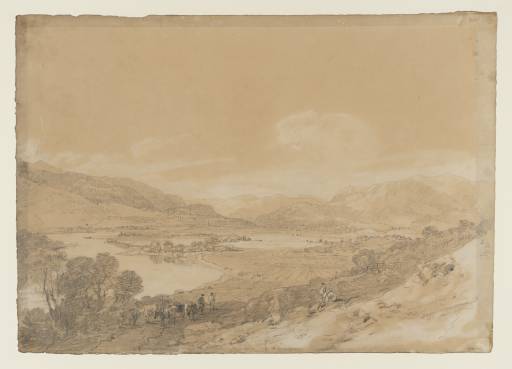Joseph Mallord William Turner ?The River Tay North of Dunkeld, Looking North towards Pitlochry 1801
Joseph Mallord William Turner,
?The River Tay North of Dunkeld, Looking North towards Pitlochry
1801
Joseph Mallord William Turner 1775–1851
?The River Tay North of Dunkeld, Looking North towards Pitlochry 1801
D03436
Turner Bequest LVIII 57
Turner Bequest LVIII 57
Pencil and gouache on white wove paper prepared with a grey–buff wash, 346 x 481 mm
Stamped in black ‘LVIII – 57’ bottom right
Stamped in black ‘LVIII – 57’ bottom right
Accepted by the nation as part of the Turner Bequest 1856
Exhibition history
1869
First Loan Collection selected from the Turner Bequest, various venues and dates 1869–1931 (no catalogue but numbered 142, as ‘Highland River’).
References
1801
A.J. Finberg, A Complete Inventory of the Drawings of the Turner Bequest, London 1909, vol.I, p.159, LVIII 57, as ‘Highland river’, c.1801.
1991
Ian Warrell, ‘R.N. Wornum and the First Three Loan Collections: A History of the Early Display of the Turner Bequest Outside London’, Turner Studies, vol.11, no.1, Summer 1991, p.42 no.142, as ‘Highland River’.
Technique and condition
The composition was begun with light, sketching, using a hard graphite pencil, for the mountain tops and the more distant trees, on white wove Whatman paper that had previously been lightly washed all over to give a pale greyish buff background. The warm brown wash that defines the land in the foreground and the mountains, leaving a reserve unpainted for the water, was applied next. This in effect created the sky as another, larger, reserved area of buff-washed paper.
A softer, blunter graphite pencil was used for depicting the craggy mountain slopes and providing detail to the foreground, as well as sketching in distant trees. Pencil shading created the trees and some of the topography in the foreground. Light applications of white gouache, applied quite liquid, economically and rapidly provided highlights on the water, created clouds close to the mountain tops, foreground detail, and gave some characterisation to the figures, previously hastily sketched and shaded in pencil. The concentration of clouds at low level defines the weather on that day, without the need for Turner to apply any paint to the upper reaches of the sky.
This sketch has in the past been covered by a window mount, and exposed to light for a considerable period. This has severely faded the greyish buff overall wash, and has also darkened the paper to a pale brown, giving the whole image a much warmer tonality today. The white gouache has not apparently changed colour, but its impact must have changed, since it now contrasts with brown washes and reserved areas, instead of with substantial areas of unpainted grey background, more localised brown washes, and grey pencil marks.
The artist and diarist Joseph Farington noted in 1802 that Turner ‘showed me his sketches made in Scotland. Those made with black lead pencil on white paper tinted with Indian ink and Tobacco water and touched with liquid white of his own preparing’. This description can be applied here: the greyish buff wash could have been made with Indian ink combined with a brown material, since Indian ink by itself makes a very neutral grey wash of a cooler tone than that used here. Brown fading out of the mixture and yellowing paper would combine to give the background colour seen here, which would be warmer now than when newly painted. Chewing tobacco would be expected to create a warm brown liquid that would sink into the paper and create soft fuzzy outlines of the type seen here, so it could have been used diluted, for the warmer wash of the landscape. This improvised, somewhat unusual material has never been analysed in terms of materials. Indeed, there are no well-known references to its use by other artists.
‘Black lead pencil’ is in effect the graphite pencil familiar today, though Turner’s drawing material have been used in a holder that gripped a rod or fragment of material and permitted use right down to the end of the stump. Farington’s description of a ‘liquid white’ is telling: this gouache is spread very thinly over large areas, yet it has a delicate, insubstantial appearance, most easily achieved by applying it very diluted. Turner’s ‘own preparing’ probably means that Turner himself had previously ground dry chalk pigment into gum water, using a glass muller on a glass plate. In a few other works, analysis of the gum medium suggests that Turner had a preferred mixture of gums: gum arabic with added gum tragacanth. The inclusion of gum tragacanth affects the 'wash-up' of the paint, that is, the degree to which a new brushstroke dissolves and disturbs those already on the paper. More gum tragacanth means less disturbance of previous washes, and more control over the hard or soft outline to the last brushstroke applied to the paper. Analysis of Turner’s travelling watercolour now at the Royal Academy of Arts, London, has shown that this gum mixture occurs in commercial watercolour blocks. At the period of this study, Turner might even have bought the ingredients to make his own gum water.
Helen Evans
October 2008
Revised by Joyce Townsend
February 2011
How to cite
Helen Evans, 'Technique and Condition', October 2008, revised by Joyce Townsend, February 2011, in Andrew Wilton, ‘?The River Tay North of Dunkeld, Looking North towards Pitlochry 1801 by Joseph Mallord William Turner’, catalogue entry, May 2013, in David Blayney Brown (ed.), J.M.W. Turner: Sketchbooks, Drawings and Watercolours, Tate Research Publication, April 2016, https://wwwHow to cite
Andrew Wilton, ‘?The River Tay North of Dunkeld, Looking North towards Pitlochry 1801 by Joseph Mallord William Turner’, catalogue entry, May 2013, in David Blayney Brown (ed.), J.M.W. Turner: Sketchbooks, Drawings and Watercolours, Tate Research Publication, April 2016, https://www

